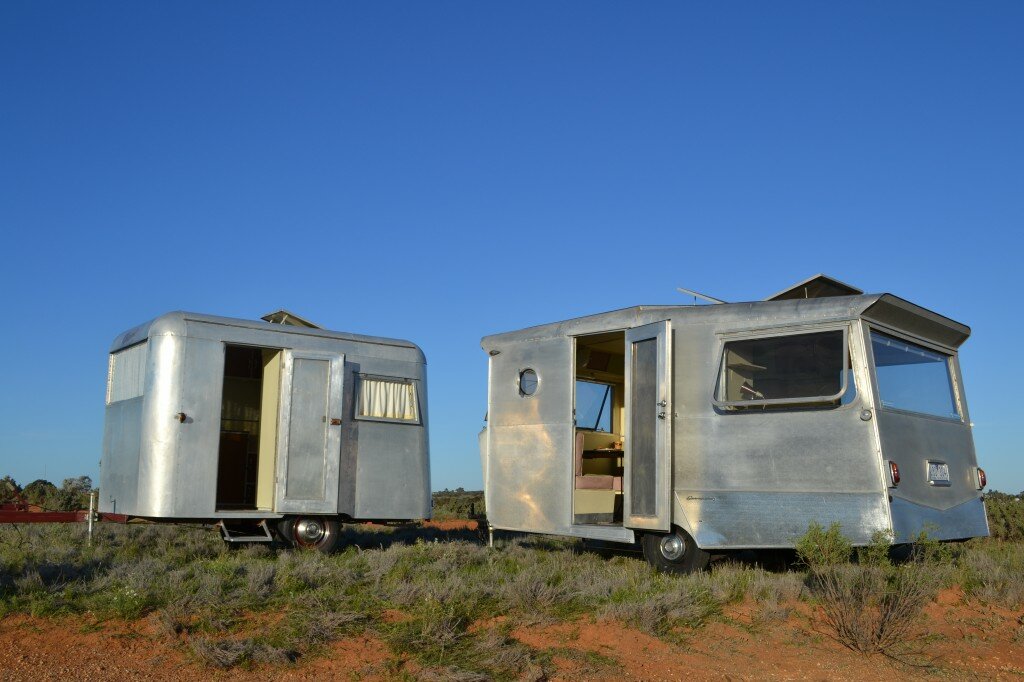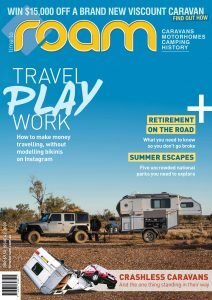Australians love nicknames and they love caravans, but there is only one caravan that has a nickname all its own.
Caraparks are fondly referred to as “The Toaster” thanks to their shiny metallic box appearance. Not at all aerodynamic to tow, back in the 1950s, competitors unkindly referred to them as “pie boxes”.
If you grew up in Australia in the 1950s or 60s, it’s highly likely the distinctive Carapark was the first caravan you saw.
When production peaked in the 1950s they accounted for 50 per cent of all caravans on the road, with sales boosted by sophisticated marketing and endorsements by some of the biggest stars of the day.
Not only were they popular with holidaymakers, Caraparks also cornered the commercial market as caravans provided much-needed accommodation for businesses as Australia expanded rapidly after the war.
The Carapark name could be found on food vans, mine site offices, TB health screening units and mobile army recruitment offices. They were custom made for almost every purpose. Those built for Snowy Mountains scheme workers came with adjustable legs to keep them above the snow.
The story of the rise and fall of quirky Carapark is also a fascinating chapter in Australia’s corporate history.
The Aussie Airstream?
Collectors love to draw comparisons between the shiny metal Caraparks and the sleek American Airstream trailers. Their caravan so aerodynamic, ours quite the opposite. That’s part of the appeal for Carapark devotees.
Where we do win in the bragging rights is that both stories started out much the same, only the Carapark began a year before Airstream.
In 1928 Sydney businessman RJ (Ron) Rankin built a small covered wagon for himself, which proved so popular, he decided to go into commercial production. He established the business Caravan Park Pty Ltd.
The first factory was situated in the inner Sydney suburb of Newtown, directly across the road from the Propert motor body works factory – a company later finding fame with its folding caravans.
While Rankin’s early canvas roof models were basic in construction, they came equipped with ice chests, water tanks and even electric lighting.
As roads improved and cars became more powerful in the 1930s, Rankin could see that caravans would become bigger and more sophisticated, with many of the conveniences of the modern home.
And so in 1939 “The Toaster” was born. It was Rankin’s penultimate model, the all-steel Superb was equipped with every luxury imaginable at the time and was road tested on rough outback tracks, going as far as Darwin.
Ron Rankin believed every Australian car should be coupled with a caravan, but the outbreak of war meant his dream was put on hold.
The Newcastle link
Even after the war, petrol rationing and material shortages made business tough. Success finally came to Rankin when he teamed up with Newcastle businessman John Walsh in 1952.
Walsh apparently had a knack of getting around post-war material shortages and had built a new factory in the inner suburb of Mayfield not far from the steelworks where he built his own line of Newcastle Caravans.
Exactly how they came together remains a mystery.
The story out of Newcastle is that Rankin sold off his Sydney operations to buy into Newcastle Caravans, although given Rankin had a fairly large national presence already, some think that unlikely. However they came together, the pair proved unstoppable. Adopting the name Carapark for the first time, the company expanded rapidly with a stock market float raising a quarter of a million pounds.
The production line at Mayfield soon became the most sophisticated in Australia. Once materials became more available it was able to turn out a new caravan at the then unprecedented rate of one every two days.
By the mid 1950s, the power of cars and material supplies picked up to the point where Carapark could fulfill Rankin’s dream of building all metal caravans, with bondwood giving way to aluminum models.
An ad from 1955 shows four in the Carapark range at that time, starting with the Hunter Junior, a mini toaster just over 10ft long and sleeping three, followed by two Superb models and the top of the range Hunter Special four berth.
By the late 1950s when Carapark reached its peak, the factory had 80 workers turning out a shiny new aluminium caravan every four hours.
The company then expanded to Melbourne with a second factory producing smaller lightweight caravans called Westerns.
Want the latest in caravan reviews, travel, news and history? Subscribe to ROAM
- Breaking – Kirribilli House to be replaced with caravan - August 24, 2018
- ROAM Issue 33 – Read It Online - May 25, 2018
- Australia’s Best Bike Tracks Near Great Campsites - December 6, 2017
- Caravan Club Donates $1000 to RACQ Life Flight - December 5, 2017
- Motorhome Review – Horizon Melaleuca Appeal - October 21, 2017
- Winton’s Dunny Derby Run and Won - September 28, 2017
- Motorhome Review – Sunliner Habitat - September 14, 2017
- Top 5 Nomad Towing Mistakes - August 25, 2017
- Camper Trailer Review – Blue Tongue Overland XF 2 - August 17, 2017
- Video – Mal Leyland visits Eden and Pambula - August 1, 2017






5 Comments
Helena
Would anyone know where i could obtain some doors which belong to the Carapark SCA & NTA Serial No. 220, i think they used these big ones for Transport and Works in the NT, a few were given to our community and we set up the school in them – now 20 odd years later we are refurbishing them for a grassroots rehab, would love some doors which actually fit them.
Rory walker
Ive just referbed a Carapark caravan, it was part pf my gap year. Does anyone have any info on them as mine has a Franklin sticker on it and a forrest commission ( ovens ) plate on it . Thanks Rory. 0432805145
Daniela Depetro
Why did they stop making Caraparks?
Brendan Batty
They couldn’t adapt to market trends (which was more mass-produced, cheaper caravans), and so eventually faded away.
Natalie Dingle
Hi,
I have done up an old aluminium carapark van. Can’t quite read the serial number but it looks like 6718 (or 8713). The model looks like 12’9. It has two port hole windows on one side. Does anyone know what year it may be?